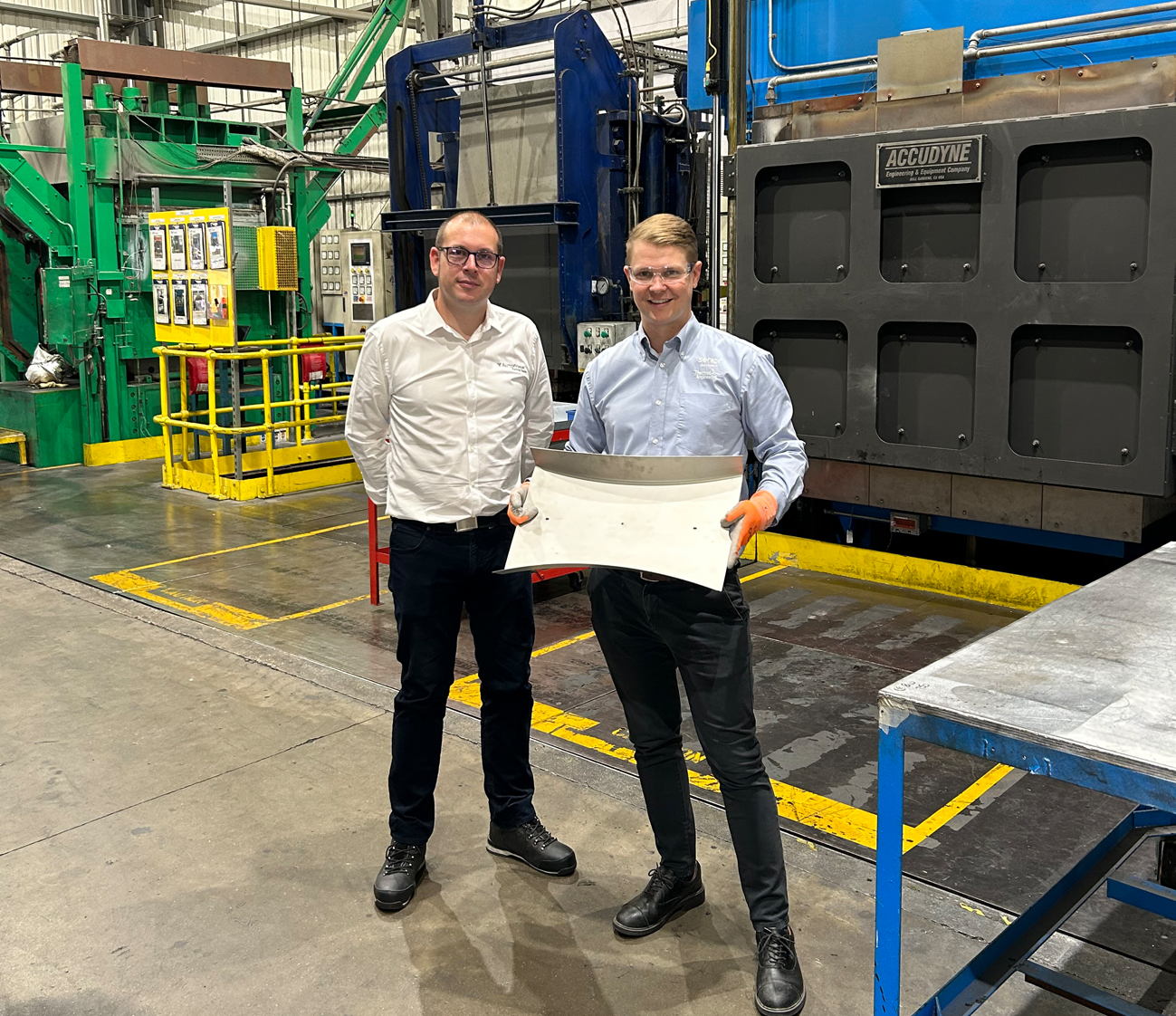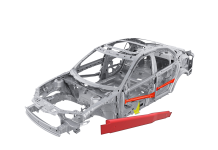Introduction
Simulation software, a longtime staple in the automobile industry, is gaining momentum in aerospace engineering for designing parts and stamping processes.
In this article, we explore adaptation of simulation software for metallic hot-forming parts at Senior Aerospace Thermal Engineering (SATE), a UK-based aerospace component manufacturer and part of Senior plc, an international manufacturer of high technology components and systems. This is part one of a three-part series.
Background on SATE
Established in 1988 by brothers Jeff and Trevor Milton, SATE was acquired by Senior plcis in 2013, becoming a more prominent player in the aerospace forming industry. Senior plc, a FTSE250 international engineering group that manufactures high technology components and systems.
SATE is equipped with four large isothermal hot forming presses that can reach up to 1000°C, facilitating the hot-blank, hot-tool process essential for specialised aerospace component manufacturing. These presses are primarily used to form titanium alloys.
SATE’s hot-die quench facility primarily processes large parts crafted from nickel-based alloys. This intricate process involves heating the part to high temperature (~1000°C) before rapidly transferring it to an ambient temperature tool for deep-drawing to create the final profile. SATE also has an in-house aluminum processing facility with heat treatment and forming capabilities including stretch forming, deep-drawing, and flanging.
As well as hot-forming sheet metal fabrication, SATE specialises in thermal insulation systems, where forming also plays a pivotal role in the production process. Utilising unique capabilities, SATE rigidizes thin gauge material before using presses to produce formed skins that are later used to encapsulate insulation material, thus creating a thermal barrier between the component and operating environment. Insulation systems account for approximately half of SATE’s business portfolio.
SATE relies on its three laser cutting machines for blank and part trimming, and they also provide support services in fabrication, machining, non-destructive testing, and chemical treatments for the removal of surface oxides from formed parts.

Fig. 1: Tom Scott from AutoForm with Darren Godfrey from SATE.
Traditional Forming Methods at SATE
For decades, SATE followed the traditional forming process of an iterative approach to tool and process design. When embarking on a New Product Introduction (NPI) project, department heads would estimate the blank shape, form it, evaluate the resulting part for any problem areas. The engineers would return to the CAD station, adjust the blank parameters, re-cut the blank, and re-form the part and repeat the entire cycle until the tooling and process was considered acceptable.
Typically, this trial-and-error method would require up to eight iterations, along with sufficient material for experimentation.
With costly titanium alloy Ti-6-4 (Ti6Al4V) making up 85-90% of SATE’s hot forming material, this iterative process incurred substantial expenses and relatively long lead times to successful industrialisation. A single sheet of Ti-6-4, costing approximately £2,000, would typically yield four medium-sized components. With two sheets needed for try-outs, along with engineering fees and laser cutting expenses, the costs would quickly escalate, easily surpassing £5,000 before a press was switched on.
The pre-production costs, however, were only part of the problem. The specialised hot forming process also incurred significant costs, with each part requiring exposure to high temperatures in the press for upwards of 40 minutes. Repeating the same process until a satisfactory product was achieved led to costs totaling tens of thousands of pounds per NPI project. The entire process could also take weeks, making NPI projects potentially neither as quick nor as affordable as SATE would have liked.
The iterative trial-and-error method also often prevented the engineering team from enhancing the part beyond minimum requirements, with the team hesitant to pursue further improvements because of the time and costs involved.
The Move to Simulation
Transitioning from traditional development methods to simulation has long been a priority for SATE, to save both time and money expended in reaching the manufacturing stage. Simulations would not only accelerate NPI projects but also boost SATE’s competitive edge in securing new those projects. The prospect of presenting customers with a comprehensive evaluation of process effectiveness, tool scale, and associated costs would be a compelling point of difference.
However, management were aware of some potential hurdles to implementation. The concept was unfamiliar at SATE, as to that point they had relied on iterative physical prototypes. This new technology was, however, quickly and enthusiastically embraced after the first part was stamped using a tool designed in AutoForm.
How Simulation Helped
Simulation revolutionised NPI projects and operations at SATE, offering numerous advantages over conventional methods. Some key benefits include:
1. Highly Accurate Ti-6-4 Model:
AutoForm’s Ti-6-4 model at 700 degrees proved highly accurate, helping tremendously with formability and feasibility assessments. The results were both fast and reliable.
2. Easy to Pick Up:
SATE is manufacturing process focused, meaning AutoForm is predominantly used by manufacturing and tooling engineers. While these experts excel at practical applications, they may have varying levels of theoretical part forming knowledge. The intuitive nature of the AutoForm workspace meant that SATE’s engineers were able to quickly learn the software through self-study and training and become self-sufficient within a year.
3. Business Growth:
AutoForm’s ability to accurately simulate a variety of forming simulations gave SATE a competitive advantage in NPI project bids. Detailed assessments of a design’s feasibility allowed the engineers to explain particular processes and provide detailed specifications through live simulations and videos before cutting a blank. Blank development plays a critical role in the company’s work, both in aiding formability and reducing material costs. Through these offerings, simulation helped inspire confidence in customers and enabled SATE to win more projects.
4. Development of Tool Designs Within the Software:
One of AutoForm’s most unexpected benefits was the ability to develop and modify tool designs directly within the software. Unlike other options requiring users to revert to CAD for modifications, AutoForm’s integrated tool design feature saved significant time and provided toolmakers with the basis to create their final tool design, defining key details such as tool size, forming surface, forming angle and blank location.
Conclusion
By integrating simulation software into their workflow, SATE drove a transformative leap in forming accuracy and efficiency, whilst also providing their customers with the confidence required to award work packages in a highly competitive market.
Streamlining the manufacturing process considerably reduced iterative trial-and-error loops, allowing the team to meet tight delivery deadlines through virtual iterations without compromising quality.
In addition to reducing the production costs, simulation also enhanced product quality by virtually highlighting and rectifying potential issues. It also made the entire NPI process more sustainable by reducing material wastage.
In summary, the integration of forming simulation has made SATE an agile, future-ready, and resource-conscious, strengthening their core metallic forming and insulation capabilities.













